My kinders are learning about the lines and spaces of the music staff (we're past the whole -higher/lower, two lines, three lines, sort of prep stuff). I have a really cute activity for lines and spaces that involve stars that I'll post about later.
For now, here's an idea that I've used with past week:
The large staff is a painted shower-curtain (easy and surprisingly durable).
The penguins are little figures I made and then cut out and laminated (also pretty durable).
To play, I move the penguins off the staff and tell the students a blizzard has happened. We wave our hands up and down while making a "whoo" sound (like the wind blowing).
Then, we sing this (to the tune of "I'm a little teapot")
I'm a little penguin on the staff
Watch me waddle and try not to laugh
Can you please help me find my place
On a line or on a space
While we're singing, I choose a student to put each penguin (one by one, so we sing 5 times for the lines and 4 times for the space) on the correct place.
Pages
▼
Thursday, December 12, 2013
Veni Veni Emmanuel
"Just for fun" this month, my 5th graders are busy working on "Veni, Veni, Emmanuel". This is a great piece for this time of year and it incorporates rhythms the students can read (such as the dotted half note) and pitches (like low la). It has also opened up discussion about sacred and Renaissance music.
My kiddos are singing in the original Latin. We also add in hand-drums (played with a soft mallet) on the half note beat, tambourines (they play the rhythm of "Gaude" only) and recorder (little over-achievers of mine). These instruments really give our performance an authentic sound.
I made a little page for them to put into their interactive notebook. See below:
I've been going over this song for about the last 5 or 6 lessons. We discuss a fact each lesson. I've created a PowerPoint for that (if you'd like to use these slides, you can copy and paste the pictures or email me at ehinz@lcps.k12.nm.us and I'll send them to you):
The students have also enjoyed watching and listening to other musicians perform this piece. Our two favorites are:
And of course, Mrs. Fricke LOVES the cello:
We're even planning to do an impromptu performance of this for our teachers! How exciting!!!!
My kiddos are singing in the original Latin. We also add in hand-drums (played with a soft mallet) on the half note beat, tambourines (they play the rhythm of "Gaude" only) and recorder (little over-achievers of mine). These instruments really give our performance an authentic sound.
I made a little page for them to put into their interactive notebook. See below:
I've been going over this song for about the last 5 or 6 lessons. We discuss a fact each lesson. I've created a PowerPoint for that (if you'd like to use these slides, you can copy and paste the pictures or email me at ehinz@lcps.k12.nm.us and I'll send them to you):
The students have also enjoyed watching and listening to other musicians perform this piece. Our two favorites are:
Saturday, November 30, 2013
Christmas/Winter Materials
 |
| Love this cute add from Kristin at Creative Clips |
These three bear-themed lessons are great for ages K-2. I love using them around this time of year because the bears are "hibernating".
Speaking of bears, I created the song "Klondike" as a new so and mi lesson:
These folders are always a big hit with K-2 (and really handy if someone is covering your class while you do a holiday rehearsal or performance) - you'll find 5 winter/holiday-themed folder games to choose from (click here for a freebie Gingerbread themed game):
This original song (with a corresponding partner song and instrumentation ) is really handy for 2nd graders working on mi so la:
These mi-so-la based penguin songs I use with 1st graders:
If you're ready to add in do, check out this do mi so la snowman activity that also walks students through the steps of creating their own piece:
This song is great for reviewing the Do pentatonic pitches (you'll find extensive instructions, teaching slides, instrumentation you can use for a performance and more):
These games are cute for students who need to review most basic melodic concepts (bag and bage on recorder, treble clef spelling, mi/so, mi/so/la, do/mi/so/la, do/re/mi, do/re/mi/so, do/re/mi/so/la)
My older students enjoy "learning" this piece (I've used it in a 5th grade winter program, but now we usually learn the melody during the last week of classes in December as a fun activity)
Another great song for older students is "Go Tell It On the Mountain" (this includes a printable activity):
I like using this song for reinforcing the half note (with 2nd):
I created this activity for older students to review the pitches of the treble clef (the levels progress from 3 to 7 letters):
In my bundle, "A Musical Wonderland" you'll find all of these resources and much more - check it out:
Best of luck during these next few busy weeks - I know I'll be swamped!
Friday, November 22, 2013
5th Grade Solfa Dojo
My 5th graders are working on extended do pentatonic. I'm always telling them I've "grown" them because this is my third year with them and they are just doing wonderfully - definitely strong musicians and performers.
Anyway, at the beginning of the lesson, they work on a sight-reading example as a class. I've based it on my "solfa dojo" (it corresponds to "recorder karate" which they are familiar with). You can find the idea on my TPT store and download it for free.
First, the students chant the rhythm of the song (they can earn 1 to 3 points for this).
Then, the students chant the solfa of the song (they can earn 1 to 3 points for this).
Lastly, the students sing the song on the solfa with hand signs (they can earn 1 to 3 points for this).
This has been going very well with my kiddos (we're on our green belts now). Before they perform each section (rhythm - chant solfa - sing solfa) they are allowed to discuss the answers with each other. It is just totally precious to hear them talk to each other - for example, "No, that can't be a mi because it isn't on a line and do is on a line" or "That's a la - see how high it is?"
To give it a holiday theme and extra motivation, the kiddos get to color in a candy-cane after each song they complete. I'm sure all the classes will end up tying each other, but right now they are busy competing. As a reward, they'll be receiving a candy-cane from me at their class holiday party (the day before Winter Break starts). After browsing Target, I believe, I saw some pipe-cleaners that are red and white - I'm thinking that might be better because we could mold it into different shapes and sing them (vocal exploration), then twist them into a quarter note. We'll see...
Anyway, at the beginning of the lesson, they work on a sight-reading example as a class. I've based it on my "solfa dojo" (it corresponds to "recorder karate" which they are familiar with). You can find the idea on my TPT store and download it for free.
First, the students chant the rhythm of the song (they can earn 1 to 3 points for this).
Then, the students chant the solfa of the song (they can earn 1 to 3 points for this).
Lastly, the students sing the song on the solfa with hand signs (they can earn 1 to 3 points for this).
This has been going very well with my kiddos (we're on our green belts now). Before they perform each section (rhythm - chant solfa - sing solfa) they are allowed to discuss the answers with each other. It is just totally precious to hear them talk to each other - for example, "No, that can't be a mi because it isn't on a line and do is on a line" or "That's a la - see how high it is?"
To give it a holiday theme and extra motivation, the kiddos get to color in a candy-cane after each song they complete. I'm sure all the classes will end up tying each other, but right now they are busy competing. As a reward, they'll be receiving a candy-cane from me at their class holiday party (the day before Winter Break starts). After browsing Target, I believe, I saw some pipe-cleaners that are red and white - I'm thinking that might be better because we could mold it into different shapes and sing them (vocal exploration), then twist them into a quarter note. We'll see...
Wednesday, November 20, 2013
Thanksgiving Dinner Foods
Since my 1st graders are super busy with the music for their Winter Program, this year my Kinders (yes, Kinders - they are doing so well) are working with Thanksgiving Rhythms (you can find this activity and other lessons and printables in this download from my TPT store):
First, we discuss each food you see below:
Then, we sit in a circle and chant (while keeping the steady beat):
We will eat your dinner,
Whatever you might pick,
But we won't eat those monkey brains
'Cause that will make us sick!
We pass around a little stuffed turkey while we chant this. Whatever child the turkey lands on chooses a food, and then we figure out the rhythm that goes with the food. (The kiddos are pretty solid on "ta" and "titi", so now we're working on combining them into two or four beat phrases)
So:
Quarter Note: corn, bread
Eighth Note Pair: gravy, turkey
Eighth Note Pair and Quarter Note: casserole, pumpkin pie
Once we know what the rhythm of the food is, we turn it over and it is "eaten". The kiddos enjoy it and the whole activity doesn't take too long to complete.
With my 1st graders, we usually complete this worksheet:
I don't know about you, but cutting and pasting with kinders is just not something I want to do. To practice the rhythms this year, we're using Amy Abbott's wonderful set of "Thanksgiving Dinner Rhythms". The kinders are only using "corn" and "turkey" but they're having fun creating the rhythms. Then, we move them to high and low pitch levels (prepping for so and mi) and use our singing voice.
Lots of fun!
First, we discuss each food you see below:
Then, we sit in a circle and chant (while keeping the steady beat):
We will eat your dinner,
Whatever you might pick,
But we won't eat those monkey brains
'Cause that will make us sick!
We pass around a little stuffed turkey while we chant this. Whatever child the turkey lands on chooses a food, and then we figure out the rhythm that goes with the food. (The kiddos are pretty solid on "ta" and "titi", so now we're working on combining them into two or four beat phrases)
So:
Quarter Note: corn, bread
Eighth Note Pair: gravy, turkey
Eighth Note Pair and Quarter Note: casserole, pumpkin pie
Once we know what the rhythm of the food is, we turn it over and it is "eaten". The kiddos enjoy it and the whole activity doesn't take too long to complete.
With my 1st graders, we usually complete this worksheet:
I don't know about you, but cutting and pasting with kinders is just not something I want to do. To practice the rhythms this year, we're using Amy Abbott's wonderful set of "Thanksgiving Dinner Rhythms". The kinders are only using "corn" and "turkey" but they're having fun creating the rhythms. Then, we move them to high and low pitch levels (prepping for so and mi) and use our singing voice.
Lots of fun!
Sunday, November 10, 2013
Interactive Notbooks - Update
UPDATE: Hello everyone! I have been at a new school with nearly 3x the students! Eek! Interactive notebooks haven't been feasible here, so I haven't been keeping up with them. I do have some of the things I've use available for free (see the links below) and I'm working on uploading more!
https://www.teacherspayteachers.com/Product/Music-Interactive-Notebook-Pages-Rhythms-475383
https://www.teacherspayteachers.com/Product/Music-Interactive-Notebook-Pages-Dynamics-Tempos-Articulations-424104
I know that a few of you are on the "interactive notebook" journey with me. I haven't been "journey-ing" very well in October, because, well, Halloween songs and activities are my absolute favorite and my students and have been busy!
However, I'm hoping to get these updates into my students' notebooks ASAP. Check them out!
This easy foldable can be used for logging "new rhythms". The rhythm is drawn in the middle. The flaps read: "real name", "word with same number of sounds", "number of sounds", "number of beats". You can see below how I answered these for "tika-tika".
Here's another rhythm foldable - this one is cross-curricular. Check-out how the kiddos have to identify the rhythm and then create a bar-graph:
Isn't it convenient that the lines on the music staff equal the number of fingers on the human hand? :)
I can't wait to add this little picture in as we go over absolute pitch:
The foldables are for basic listening vocabulary words. I'm thinking about introducing one type (say "tempo") per lesson, paired with interesting listening examples (I love Eric Chapelle's "A Tale of Two Cities" for loud vs. quiet - Half the class is the "loud city" and they stomp around the room with big movements, the other half is the "quiet city" and they tip-toe around with small movements - lots of fun for any age). After we listen or move to some of the terms, the students can complete their notebook pages (see below). The students can find the answers on various posters, anchor charts, etc around the room.
Now, anytime we listen to a piece, the students can uses these pages as a reference. I think this will be very engaging because they'll get to flip into their own work, check out pictures, and read what they wrote as the definition.
I'm literally slapping myself for not thinking of these pages sooner. My 4th graders are going to an orchestral concert on Thursday, so I've been very busy with them reviewing the instruments of the orchestra. We used a few charts in our notebooks already to log in notes about each instrument, but, had I had these printables glued in for them to use, I think their work would have been much better organized (and the pictures can't hurt either). I'll definitely be using these with my 3rd and 5th graders.
I'd suggest teaching one family per lesson (I love to use SFS Kids when teaching the instruments). Students can take notes under each flap and add extras (such as other family members, playing techniques, etc) around the edges of the foldable. Supplement their note-taking with discussions and video-clips from Youtube.
Looking for more instruments of the orchestra activities? Check out these FREEBIES from my TPT store:
Brass Family Matching Game
Woodwind Family Matching Game
Percussion Family Matching Game
String Family Matching Game
Turkey Instrument Family Game
How are your notebooks going?
https://www.teacherspayteachers.com/Product/Music-Interactive-Notebook-Pages-Rhythms-475383
https://www.teacherspayteachers.com/Product/Music-Interactive-Notebook-Pages-Dynamics-Tempos-Articulations-424104
I know that a few of you are on the "interactive notebook" journey with me. I haven't been "journey-ing" very well in October, because, well, Halloween songs and activities are my absolute favorite and my students and have been busy!
However, I'm hoping to get these updates into my students' notebooks ASAP. Check them out!
This easy foldable can be used for logging "new rhythms". The rhythm is drawn in the middle. The flaps read: "real name", "word with same number of sounds", "number of sounds", "number of beats". You can see below how I answered these for "tika-tika".
Here's another rhythm foldable - this one is cross-curricular. Check-out how the kiddos have to identify the rhythm and then create a bar-graph:
Isn't it convenient that the lines on the music staff equal the number of fingers on the human hand? :)
I can't wait to add this little picture in as we go over absolute pitch:
The foldables are for basic listening vocabulary words. I'm thinking about introducing one type (say "tempo") per lesson, paired with interesting listening examples (I love Eric Chapelle's "A Tale of Two Cities" for loud vs. quiet - Half the class is the "loud city" and they stomp around the room with big movements, the other half is the "quiet city" and they tip-toe around with small movements - lots of fun for any age). After we listen or move to some of the terms, the students can complete their notebook pages (see below). The students can find the answers on various posters, anchor charts, etc around the room.
Now, anytime we listen to a piece, the students can uses these pages as a reference. I think this will be very engaging because they'll get to flip into their own work, check out pictures, and read what they wrote as the definition.
I'm literally slapping myself for not thinking of these pages sooner. My 4th graders are going to an orchestral concert on Thursday, so I've been very busy with them reviewing the instruments of the orchestra. We used a few charts in our notebooks already to log in notes about each instrument, but, had I had these printables glued in for them to use, I think their work would have been much better organized (and the pictures can't hurt either). I'll definitely be using these with my 3rd and 5th graders.
I'd suggest teaching one family per lesson (I love to use SFS Kids when teaching the instruments). Students can take notes under each flap and add extras (such as other family members, playing techniques, etc) around the edges of the foldable. Supplement their note-taking with discussions and video-clips from Youtube.
Looking for more instruments of the orchestra activities? Check out these FREEBIES from my TPT store:
Brass Family Matching Game
Woodwind Family Matching Game
Percussion Family Matching Game
String Family Matching Game
Turkey Instrument Family Game
How are your notebooks going?
Sunday, November 3, 2013
Mi So La Tic-Tac-Toe
I love using tic-tac-toe and bingo format games with the kiddos. They don't even mind that I never give out prizes for winners, haha (so cheap).
They are a really great opportunity for students to practice ear-training and for me to assess who can read the patterns and who can't.
I usually follow these steps when I use such activities (I'm huge into getting the most I can out of anything we do, especially if it takes me forever to create and/or assemble):
Prep: Students sing each pattern on solfa as a whole class. I make sure the students know where each solfa is living. Students sometimes play individually and sometimes with a partner.
Level 1: I sing a pattern on solfa three times. After the third repeat, I announce the correct number so students can check their work (while I'm singing, I'm walking around and watch the students to see who quickly covers the correct answer, who covers the correct answer after subsequent repeats of the patterns, and who doesn't cover a pattern or covers the wrong pattern). Sometimes we get a tic-tac-toe or bingo at the same time, but it doesn't matter to the kiddos. After about three or four repeats of this level, we move on.
Level 2: This level is the same as level one, only I sing the solfa on a neutral syllable. The students will have to label the solfa themselves using their ears, and then find the correct pattern.
Level 3: For this level, I only play the pattern (usually on the piano or recorder).
Extensions: Students love to volunteer to sing a pattern for the class. This can be a bit nerve-wracking for some of them, so I usually only take volunteers. If they mess up or fail to sing on the correct pitch, often the class isn't sure what pattern to pick, so the students (especially the performers) realize how important musical accuracy is. Depending on the solfa we're using, students also enjoy playing patterns on the instruments. They can do this with a partner, with one student playing the pattern and the other trying to find it on the game-board. If the bingo board has a "free space" the students can take turns creating the "free space" pattern (which I write on the board for all to see). Only if and when I sing that pattern can the students now cover the "free space".
Try these steps out for yourself. You'll find my "Mi So La Tic-Tac-Toe" game on my TPT store as my latest freebie (click the picture below). Enjoy!
They are a really great opportunity for students to practice ear-training and for me to assess who can read the patterns and who can't.
I usually follow these steps when I use such activities (I'm huge into getting the most I can out of anything we do, especially if it takes me forever to create and/or assemble):
Prep: Students sing each pattern on solfa as a whole class. I make sure the students know where each solfa is living. Students sometimes play individually and sometimes with a partner.
Level 1: I sing a pattern on solfa three times. After the third repeat, I announce the correct number so students can check their work (while I'm singing, I'm walking around and watch the students to see who quickly covers the correct answer, who covers the correct answer after subsequent repeats of the patterns, and who doesn't cover a pattern or covers the wrong pattern). Sometimes we get a tic-tac-toe or bingo at the same time, but it doesn't matter to the kiddos. After about three or four repeats of this level, we move on.
Level 2: This level is the same as level one, only I sing the solfa on a neutral syllable. The students will have to label the solfa themselves using their ears, and then find the correct pattern.
Level 3: For this level, I only play the pattern (usually on the piano or recorder).
Extensions: Students love to volunteer to sing a pattern for the class. This can be a bit nerve-wracking for some of them, so I usually only take volunteers. If they mess up or fail to sing on the correct pitch, often the class isn't sure what pattern to pick, so the students (especially the performers) realize how important musical accuracy is. Depending on the solfa we're using, students also enjoy playing patterns on the instruments. They can do this with a partner, with one student playing the pattern and the other trying to find it on the game-board. If the bingo board has a "free space" the students can take turns creating the "free space" pattern (which I write on the board for all to see). Only if and when I sing that pattern can the students now cover the "free space".
Try these steps out for yourself. You'll find my "Mi So La Tic-Tac-Toe" game on my TPT store as my latest freebie (click the picture below). Enjoy!
Saturday, November 2, 2013
The Mayflower
My 2nd graders are about ready to add in "do". This will be one of the last strictly "mi-so-la" activities that I have them complete - so I packed with everything I could think of to enhance their learning. (Note: Although I do frequently create songs for my students to use, the folk songs I use to teach them far outnumber anything I create - as it should be).
The song is called "The Mayflower". I've included the music, feel free to use it. At my Teachers Pay Teachers store (click on the picture below to check it out), you'll find a thorough lessons with visuals, printables, movement ideas, assessment ideas, instrumentation, and more.
I'm really excited to use a few printables I created. This is a great way for me to assess the students in a way that is fun for them.
First, I'll give the students their Mayflower cards. The students will:
1) chant the rhythm of each card
2) chant the solfa of each card in rhythm
3) sing the solfa of each card on pitch
4) locate a card I sing or play on a pitched instrument
5) locate a card their classmate sings or plays
Then, the students will match the Pilgrim cards to the Mayflower cards. Once these are correctly matched, I'll collect the Mayflower cards. Then, the students will:
1) chant the rhythm of each card
2) chant the solfa of each card in rhythm
3) sing the solfa of each card on pitch
4) locate a card I sing or play on a pitched instrument
5) locate a card their classmate sings or plays
To extend this, students can:
1) Create their own two to four beat measure phrases by arranging the cards in order
2) Play the cards on a pitched instrument
3) A moveable match game - students will be given either a pilgrim or a mayflower card and will have to search for a student that has their matching card
4) Memory matching game with a partner (put cards face down, if they draw a match, they keep the pair and play again, if not, their partner takes a turn, whoever has the most cards at the end is the winner)
My 2nd graders will also be busy with Turkey, Turkey (another mi-so-la activity).
The song is called "The Mayflower". I've included the music, feel free to use it. At my Teachers Pay Teachers store (click on the picture below to check it out), you'll find a thorough lessons with visuals, printables, movement ideas, assessment ideas, instrumentation, and more.
I'm really excited to use a few printables I created. This is a great way for me to assess the students in a way that is fun for them.
First, I'll give the students their Mayflower cards. The students will:
1) chant the rhythm of each card
2) chant the solfa of each card in rhythm
3) sing the solfa of each card on pitch
4) locate a card I sing or play on a pitched instrument
5) locate a card their classmate sings or plays
Then, the students will match the Pilgrim cards to the Mayflower cards. Once these are correctly matched, I'll collect the Mayflower cards. Then, the students will:
1) chant the rhythm of each card
2) chant the solfa of each card in rhythm
3) sing the solfa of each card on pitch
4) locate a card I sing or play on a pitched instrument
5) locate a card their classmate sings or plays
To extend this, students can:
1) Create their own two to four beat measure phrases by arranging the cards in order
2) Play the cards on a pitched instrument
3) A moveable match game - students will be given either a pilgrim or a mayflower card and will have to search for a student that has their matching card
4) Memory matching game with a partner (put cards face down, if they draw a match, they keep the pair and play again, if not, their partner takes a turn, whoever has the most cards at the end is the winner)
My 2nd graders will also be busy with Turkey, Turkey (another mi-so-la activity).
Thursday, October 24, 2013
Halloween Dictation Success!
I had to share this little activity my 2nd and 3rd grade students used today. They grasped the concepts really well and made so many cute, creative little compositions.
To begin, I handed each pair of students a bag of 8 pumpkin erasers (from Target this year). You don't really need to use pumpkins though, or even anything Halloween-themed.
I chanted a line of text in a steady beat format and the students needed to figure out the rhythm (this picture, for example, shows "Pump-kin, Pump-kin, in the patch"):
Once the rhythm was correct, we moved the pumpkins to various pitch levels (my 2nd graders are working on reviewing "mi so la" so theirs was so-so, la-la, so-so, mi). The students sung the song on the solfa syllables and the correct pitches.
Then, I passed out my handy Halloween-themed staff page. The students then placed the pumpkins in the correct line or space on the staff.
We did a total of three of these "examples" together.
Then, I asked the students to think of lyrics and match rhythms to the lyrics. We shared these around the circle so we could make sure the number of pumpkins matched the rhythm. (and, to my delight, I only had to fix one or two per class, whew!)
Next, the students moved their pumpkins to different pitch levels. My 3rd graders were happy to move the pumpkins in eighth note pairs to different pitches (such as "do-re" instead of "do-do" - aren't they tricky). The students sang their melodies and I realized all of our ear-training was paying off (they were singing the correct pitch intervals!!!!). I've been requiring the students to sing soloistically more and more often, and this resulted in many students eager to sing their composition for the class.
Last, the students placed their pumpkins on the staff (again, very few errors for me to correct - aren't they smart?!) and (time allowing) we shared them with the class. I wrote down a few exceptionally cute ones to use as vocal ostinatos next time (how excited will they be to teach their composition to the class).
So, in one little activity that the students LOVED, I got to assess (without handing out a gross worksheet - I mean, gross, gross, gross):
1. Who understands how to match rhythms to lyrics
2. Who can sing the pitches correctly
3. Who understands the pitch relationships on the staff
My 3rd graders who finished early had to tell me where steps, skips, and repeats occurred in their composition. You could even extend this to have them notate their song in different keys. I also had the idea to (when everyone has a composition notated), sing on a neutral syllable or play on the recorder a student composition and have the students pinpoint which one I was performing (ear-training, ear-training).
Sorry if I'm gushing a bit - I was just soooo proud of their work. You have got to give this a try!
To begin, I handed each pair of students a bag of 8 pumpkin erasers (from Target this year). You don't really need to use pumpkins though, or even anything Halloween-themed.
I chanted a line of text in a steady beat format and the students needed to figure out the rhythm (this picture, for example, shows "Pump-kin, Pump-kin, in the patch"):
Once the rhythm was correct, we moved the pumpkins to various pitch levels (my 2nd graders are working on reviewing "mi so la" so theirs was so-so, la-la, so-so, mi). The students sung the song on the solfa syllables and the correct pitches.
Then, I passed out my handy Halloween-themed staff page. The students then placed the pumpkins in the correct line or space on the staff.
We did a total of three of these "examples" together.
Then, I asked the students to think of lyrics and match rhythms to the lyrics. We shared these around the circle so we could make sure the number of pumpkins matched the rhythm. (and, to my delight, I only had to fix one or two per class, whew!)
Next, the students moved their pumpkins to different pitch levels. My 3rd graders were happy to move the pumpkins in eighth note pairs to different pitches (such as "do-re" instead of "do-do" - aren't they tricky). The students sang their melodies and I realized all of our ear-training was paying off (they were singing the correct pitch intervals!!!!). I've been requiring the students to sing soloistically more and more often, and this resulted in many students eager to sing their composition for the class.
Last, the students placed their pumpkins on the staff (again, very few errors for me to correct - aren't they smart?!) and (time allowing) we shared them with the class. I wrote down a few exceptionally cute ones to use as vocal ostinatos next time (how excited will they be to teach their composition to the class).
So, in one little activity that the students LOVED, I got to assess (without handing out a gross worksheet - I mean, gross, gross, gross):
1. Who understands how to match rhythms to lyrics
2. Who can sing the pitches correctly
3. Who understands the pitch relationships on the staff
My 3rd graders who finished early had to tell me where steps, skips, and repeats occurred in their composition. You could even extend this to have them notate their song in different keys. I also had the idea to (when everyone has a composition notated), sing on a neutral syllable or play on the recorder a student composition and have the students pinpoint which one I was performing (ear-training, ear-training).
Sorry if I'm gushing a bit - I was just soooo proud of their work. You have got to give this a try!
Sunday, October 20, 2013
The Turkey Dance
By the time November rolls around (fingers crossed) I'll be working with my older kiddos (4th and 5th) on low so.
I created this little song for us to have some fun (and extra practice) with low so. It is called "The Turkey Dance".
Here's a slide of the verse:
Here's a slide of the refrain:
I've created slides for teaching the song (starting with the lyrics, adding the steady beat, adding the rhythmic icons, adding the rhythm, adding the solfa off the staff, adding the solfa on the staff, ending with the complete song on the staff).
I also created movements to go with the song (even my older ones like to sing and dance - I always tell them that "motions can help us remember the lyrics" and insist on complete participation).
The melodic activity that goes along with this song is what I can't wait to try out. The students are singing in a circle - singing and moving to the music. A "turkey trainer" selects as many as 8 students to hold up a turkey card:
After each repetition of the song, I can either:
A) Select a turkey for the class to sing
B) Sing or play a turkey for the class to find
If the class does so correctly, the student holding that turkey is "eaten", they turn in their card, and then they go to play an instrument (soprano, alto, bass xylophone, rhythm stick/claves, and slap stick parts are all included). Because the song is in G Major, many of my students can play it on the recorder as well.
In a subsequent lesson, the students will complete a worksheet where they label the turkeys with the correct solfa (either low so, low la, do, re, or mi).
I created this little song for us to have some fun (and extra practice) with low so. It is called "The Turkey Dance".
Here's a slide of the verse:
Here's a slide of the refrain:
I've created slides for teaching the song (starting with the lyrics, adding the steady beat, adding the rhythmic icons, adding the rhythm, adding the solfa off the staff, adding the solfa on the staff, ending with the complete song on the staff).
I also created movements to go with the song (even my older ones like to sing and dance - I always tell them that "motions can help us remember the lyrics" and insist on complete participation).
The melodic activity that goes along with this song is what I can't wait to try out. The students are singing in a circle - singing and moving to the music. A "turkey trainer" selects as many as 8 students to hold up a turkey card:
After each repetition of the song, I can either:
A) Select a turkey for the class to sing
B) Sing or play a turkey for the class to find
If the class does so correctly, the student holding that turkey is "eaten", they turn in their card, and then they go to play an instrument (soprano, alto, bass xylophone, rhythm stick/claves, and slap stick parts are all included). Because the song is in G Major, many of my students can play it on the recorder as well.
In a subsequent lesson, the students will complete a worksheet where they label the turkeys with the correct solfa (either low so, low la, do, re, or mi).

.JPG)









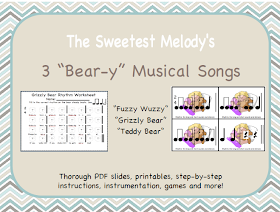
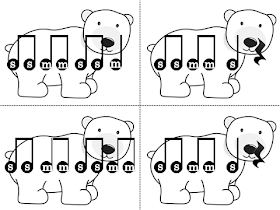


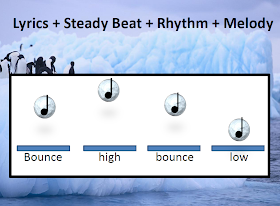
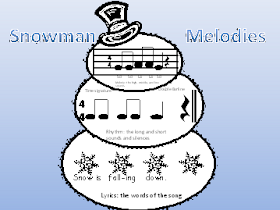
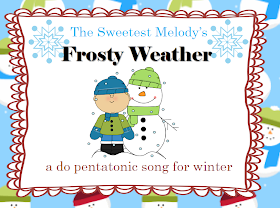
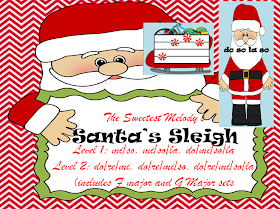

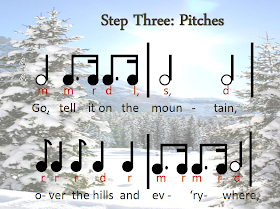






















.JPG)
.JPG)
.JPG)




